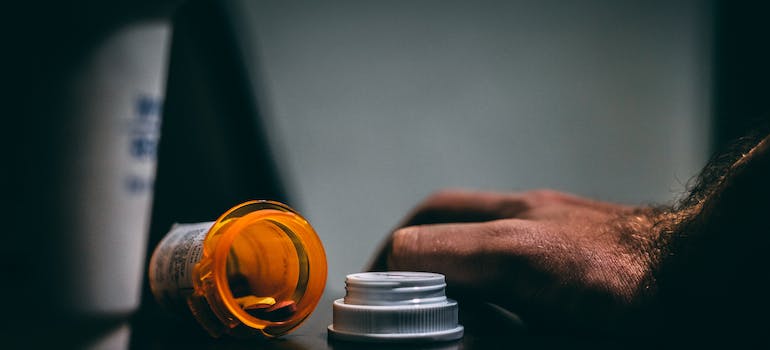Understanding the Opioid Epidemic in America
A look at the history of the opioid crisis
According to the Centers for Disease Control and Prevention (CDC), accidental drug overdoses are now the leading cause of death for people under the age of 50 in the U.S. One substance that people in the U.S. are especially dying from is opioids. This is because the U.S. is currently in the midst of an opioid epidemic. Therefore, the path to where we are now is longer and more involved than many people might know. To better understand the path that the U.S. is on now, we must first start understanding the opioid epidemic itself. Little Creek Recovery presents some important information.
Jump to Section
Know Your Substance: Opioid vs. Opiate
To further your understanding of the opioid epidemic, you need to understand the difference between an opioid and an opiate. Opiates are derived from the natural opium poppy plant. They have been used as painkillers for centuries. The most commonly used opiates in America include:
- Opium
- Morphine
- Codeine
- Heroin

Opiates are natural. Thus, people derive opiates such as heroin and opium from their natural form. But it is also possible to manufacture opiates into other substances, such as codeine or morphine.
Opioids are entirely or partially synthetic. They are very powerful. The most famous opioid is OxyContin. It is often misused and has, thus, contributed greatly to the current opioid epidemic. Vicodin, Dilaudid, Demerol, Percocet, and, of course, fentanyl are other well-known opioids that have contributed to the opioid crisis.
There is also Methadone. It is a common opioid that detox patients take to help them manage their withdrawal symptoms.
Why Has Opioid Addiction Increased So Dramatically?
In 2023, over 111,000 lives were lost to drug overdoses. The roots of the opioid crisis in the United States are complex, and its emergence could have potentially been prevented. Understanding the nuances of this epidemic is crucial. This knowledge is key to improving the effectiveness of treatment for those battling opioid addiction.
Opioids were originally developed for pain management, with OxyContin emerging as the most renowned pain reliever. OxyContin is a brand-name medication primarily composed of oxycodone, a substance significantly stronger than morphine. Its popularity soared due to a marketing campaign in the New Yorker, which highlighted its delayed-release mechanism as a way to reduce addiction risks. Consequently, healthcare providers nationwide began prescribing OxyContin at alarmingly high rates.
Another potent synthetic opioid is fentanyl, initially intended for palliative care in terminal cancer patients. Remarkably, fentanyl is 50 to 100 times more potent than morphine, and the potency gap between fentanyl and heroin is even greater. The excessive prescription of OxyContin and fentanyl raises questions about whether the prescribing doctors fully grasped the associated dangers.

Heroin Epidemic in PA and the U.S.
Heroin is a controlled substance and illicit opiate. It is far less expensive than prescription opioids and, in some cases, far easier to obtain. It is also weaker than many of the prescription painkillers on the market. This means that a person will need to use more heroin to experience the same effects that they would while using many prescription opioids.
In many cases, people who are prescribed opioids will turn to heroin if they no longer have access to opioids or can no longer long afford their prescription drugs. Because of this, there is a heroin epidemic in PA and the U.S.
These are just some of the reasons why there has been such a drastic increase in opioid and opiate addiction. An epidemic such as the opioid one that is occurring today isn’t just about one type of addict or one mitigating factor. It has spread to every corner of the country. Thus, it affects every type of person you know, from your neighbor to his father, to his grandmother, the pizza delivery guy, the local dentist, the mail carrier, the teacher, the student, and the school administrator. No one is immune to the risks.

The Escalating Opioid Overdose Crisis in the United States
The opioid overdose epidemic in the United States has escalated significantly over the past decades. From 1999 to 2021, the number of people who died from drug overdoses increased over six times, with a 16% increase in drug overdose deaths from 2020 to 2021 alone. In 2021, over 75% of the nearly 107,000 drug overdose deaths involved an opioid. The crisis has been characterized by three waves:
- First Wave: It began in the 1990s with increased prescribing of opioids, leading to a rise in deaths involving prescription opioids (natural, semi-synthetic, and methadone) since at least 1999.
- Second Wave: It started in 2010, marked by rapid increases in overdose deaths involving heroin.
- Third Wave: It began in 2013, with significant increases in overdose deaths involving synthetic opioids, especially illicitly manufactured fentanyl, which is often found in combination with heroin, counterfeit pills, and cocaine.
The Role of Different Opioids
The opioid crisis in the United States has been predominantly driven by a surge in deaths related to synthetic opioids, primarily fentanyl. This alarming trend highlights the shifting dynamics of opioid-related deaths, moving from prescription-based to illicitly produced drugs. Here are some statistics:
- Synthetic Opioids (Primarily Fentanyl): These opioids have been the primary driver of overdose deaths in recent years, with 70,601 fatalities reported in 2021. Their potency and widespread illicit manufacture have contributed to their dominance in overdose statistics.
- Prescription Opioids: While the number of deaths involving prescription opioids has seen a slight increase to 16,706 in 2021, they are no longer the leading cause of opioid-related deaths. This shift indicates a change like the epidemic, moving from prescription to illicit substances.
- Heroin: There has been a decrease in heroin-related deaths, with the number dropping to 9,173 in 2021. This trend may reflect the shift toward synthetic opioids like fentanyl.

Increasing Deaths from Stimulants and Antidepressants
Beyond opioids, the surge in overdose deaths in the United States extends to other classes of drugs, notably stimulants and antidepressants. This alarming trend reflects a broader issue in substance misuse and addiction, with these substances contributing significantly to the increasing number of fatalities. Here is a closer look at the impact of stimulants, including cocaine and methamphetamine, and the role of antidepressants in this escalating crisis, which will better our understanding of the opioid epidemic:
- Stimulants (Including Cocaine and Methamphetamine): Deaths involving stimulants have risen to 53,495 in 2021, with psychostimulants alone accounting for 32,537 of these deaths.
- Cocaine-Related Deaths: Cocaine-involved fatalities have significantly increased to 24,486 in 2021. The combination of cocaine with synthetic opioids, particularly fentanyl, has been a major factor in this rise.
- Antidepressants: The number of overdose deaths involving antidepressants has also seen a slight increase, reaching 5,859 in 2021.
Understanding the Opioid Epidemic and Fighting Back
If all of this information seems dire, be hopeful. Americans who understand the opioid epidemic are doing what they do best: rallying around the cause. Insurance companies are refusing to cover prescription opioids. States are suing the pharmaceutical companies for their role in the disbursement and advertising of the drugs.
Local communities are raising funds and awareness for free clinics. Doctors are refusing to prescribe the drugs. Together, Americans will fight this epidemic. Americans will also find a way to help those who have suffered so much because of the opioid epidemic.

CDC’s Response and Recommendations
The CDC has taken several steps to combat the opioid overdose epidemic:
- Improving Opioid Prescribing: One of the key strategies is to enhance the way opioids are prescribed, ensuring safer and more effective pain treatment while reducing misuse.
- Guidelines for Chronic Pain: The CDC has issued guidelines for prescribing opioids for chronic pain aimed at primary care clinicians. These guidelines offer a systematic approach to prescribing, focusing on opioid selection, dosage, duration, follow-up, and discontinuation, as well as assessing the risks and addressing the harms of opioid use.
- Addressing Over-Prescription: In 2012, healthcare providers wrote 259 million prescriptions for opioid pain medication, enough for every adult in the U.S. to have a bottle of pills. The CDC’s guidelines are a response to this trend of over-prescription.
- Highlighting the Risks of Opioid Use: The CDC highlights the serious risks associated with opioid pain medication use, including overdose and opioid use disorder. From 1999 to 2014, more than 165,000 people died from overdose related to opioid pain medication in the U.S.
The Need for an Ally in the Battle Against Opioid Addiction
The struggle to overcome opioid addiction is a challenging journey, emphasizing the necessity of a supportive and knowledgeable team. Such a team should possess a deep comprehension of the opioid crisis, its origins, and the complexities involved in addiction. Understanding the opioid epidemic extends beyond clinical knowledge. It includes empathy and a recognition of the unique experiences and challenges each person faces in their path to recovery.
In addition to medical professionals, this support network often includes therapists, counselors, and peer support groups. These individuals work together to provide a holistic approach to recovery, addressing not only the physical aspects of addiction but also the psychological and emotional factors. They offer guidance, support, and the necessary tools to help individuals navigate the obstacles they encounter during their recovery process.
A critical aspect of this team approach is personalized care. Each individual’s journey with opioid addiction is unique, shaped by their personal history, circumstances, and needs. Therefore, a one-size-fits-all approach is inadequate. Personalized treatment plans, tailored to meet each individual’s specific requirements, are essential for effective recovery. These plans should be flexible and adaptable, changing as the needs of the individual evolve over time.
Little Creek Recovery is your dedicated ally. As a provider of opioid addiction treatment, we specialize in crafting tailored treatment plans. Our approach is rooted in a comprehensive understanding of the opioid epidemic and a commitment to addressing the diverse needs of those we support.
Opioid and Heroin Addiction Treatment at Little Creek Recovery
At our rehab center in Pennsylvania, we focus on providing comprehensive addiction treatment programs to address:
- heroin addiction
- opioid addiction
- addiction to prescription medications
All our programs are meticulously crafted to not only empower our patients but also to ensure a lasting liberation from addiction.
Little Creek extends its expertise to a wide array of drug addiction treatments, particularly specializing in male addiction issues. Our inpatient programs are exclusively designed for men, while the outpatient services accommodate both men and women. This inclusive approach ensures that we offer suitable treatment options for various addictions, catering to a diverse range of needs within our community.
Holistic Recovery and Supportive Transition at Little Creek
Our approach at Little Creek is holistic, integrating therapeutic methods and the 12-step model with a strong emphasis on spiritual growth. This comprehensive strategy addresses the mind, body, and soul, fostering a robust foundation for recovery. Our goal is to equip patients with the necessary tools to achieve and maintain long-term sobriety.
In addition to treatment programs, we provide extensive support to help patients navigate the challenging journey from addiction to recovery. Shane’s House, our sober living facility, offers a nurturing environment for inpatients transitioning post-treatment. This additional layer of support is crucial in bridging the gap between treatment completion and independent sober living.

Receive Treatment for Opioid Addiction At Little Creek Recovery
At Little Creek Recovery, we offer a comprehensive pathway to healing for those struggling with addiction. Our treatment process begins with an in-depth assessment, leading to a personalized treatment plan. This plan often includes advanced therapy options such as:
- Cognitive Behavioral Therapy for addiction
- Dialectical Behavior Therapy for addiction
- Support for dual diagnosis cases
Recognizing the impact of addiction on family dynamics, we also incorporate a robust family program to facilitate healing and understanding among loved ones.
Our approach extends beyond immediate treatment. We also offer sober living facilities to support long-term recovery. At Little Creek Recovery, sober living is an integral part of the recovery journey. Our facilities provide a safe, structured, and supportive environment where you can transition smoothly from intensive treatment to independent living. These residences are designed to reinforce the skills and habits learned during treatment, fostering a community of mutual support and accountability. Residents engage in daily routines and responsibilities, encouraging a lifestyle of sobriety and wellness. With a focus on building a solid foundation for long-term recovery, Little Creek’s sober living facilities offer the ideal setting for you to grow, heal, and prepare for a fulfilling, substance-free life.
Confronting the Opioid Epidemic Together
The opioid crisis has cast a long shadow across the United States, with its impact touching lives in every community. At our rehab center in PA, we understand the gravity of this situation and are committed to being a beacon of hope and healing. Our comprehensive approach to treating heroin and opioid addiction reflects a deep understanding of the opioid epidemic and its complexities.
We extend a hand to those grappling with the challenges of addiction. Our doors are open, inviting you to take the first step towards a new chapter in your life. At Little Creek Recovery, you are not just a patient; you are part of a community that understands, supports, and walks alongside you in your journey to recovery. Reach out to us today and join the many who have found hope and a new beginning with us. Together, we can overcome the hurdles of addiction and build a future filled with promise and sobriety.
References:
https://www.cdc.gov/opioids/basics/epidemic.html
https://nida.nih.gov/research-topics/trends-statistics/overdose-death-rates